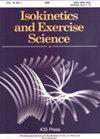Evaluation scale and definitions of core and core stability in sports: A systematic review
IF 0.7
4区 医学
Q4 ENGINEERING, BIOMEDICAL
引用次数: 0
Abstract
BACKGROUND: Core stability has been reported to be important for improving performance in athletes. However, the variety of measures used to assess core stability has made it difficult to compare results across studies. In addition, there is a lack of consensus on precise definitions of core and core stability, which is a barrier to research in this field. OBJECTIVE: The overall purpose of this review was to summarize the definitions of core and core stability and measurements of core stability used in previous studies on athletes. METHODS: We searched four electronic databases (PubMed/Medline, SPORTDiscus, Web of Science and Science Direct) from their inception to October 2023. Studies evaluating core stability in athletes across all sports were included. We excluded case studies and case series, opinion pieces, letters to editors and studies not written in the English language. Two researchers independently assessed articles for inclusion and exclusion criteria and methodological quality. RESULTS: One hundred thirty-four studies were included, of which two were of high quality. The definitions of core and core stability varied widely, and ‘core’ was not defined in 108 studies and ‘core stability’ was not defined in 105 studies. The most used test protocol was the McGill test, which was used in 19 studies. CONCLUSIONS: There are multiple tests to measure core stability, and there is some confusion as to whether the measurement results represent core strength or core endurance. Future research papers should clarify the definitions of core and core stability, and consider core strength and core endurance separately.运动中核心和核心稳定性的评估量表和定义:系统回顾
背景:据报道,核心稳定性对提高运动员的成绩非常重要。然而,由于用于评估核心稳定性的方法多种多样,因此很难对不同研究的结果进行比较。此外,人们对核心和核心稳定性的精确定义缺乏共识,这也是该领域研究的一个障碍。目的:本综述的总体目的是总结核心和核心稳定性的定义,以及以往运动员研究中使用的核心稳定性测量方法。方法:我们检索了四个电子数据库(PubMed/Medline、SPORTDiscus、Web of Science 和 Science Direct)从开始到 2023 年 10 月的内容。其中包括评估所有运动项目运动员核心稳定性的研究。我们排除了病例研究和系列病例、观点文章、致编辑的信以及非英语撰写的研究。两名研究人员根据纳入和排除标准以及方法学质量对文章进行了独立评估。结果:共纳入 134 项研究,其中 2 项为高质量研究。核心和核心稳定性的定义差异很大,108 项研究未定义 "核心",105 项研究未定义 "核心稳定性"。使用最多的测试方案是麦吉尔测试,有 19 项研究使用了该方案。结论:有多种测试可测量核心稳定性,但对于测量结果是代表核心力量还是核心耐力存在一些混淆。未来的研究论文应明确核心和核心稳定性的定义,并分别考虑核心力量和核心耐力。
本文章由计算机程序翻译,如有差异,请以英文原文为准。
求助全文
约1分钟内获得全文
求助全文
来源期刊

Isokinetics and Exercise Science
医学-工程:生物医学
CiteScore
1.20
自引率
14.30%
发文量
37
审稿时长
>12 weeks
期刊介绍:
Isokinetics and Exercise Science (IES) is an international journal devoted to the study of theoretical and applied aspects of human muscle performance. Since isokinetic dynamometry constitutes the major tool in this area, the journal takes a particular interest in exploring the considerable potential of this technology.
IES publishes studies associated with the methodology of muscle performance especially with respect to the issues of reproducibility and validity of testing, description of normal and pathological mechanical parameters which are derivable from muscle testing, applications in basic research topics such as motor learning paradigms and electromyography. The journal also publishes studies on applications in clinical settings and technical aspects of the various measurement systems employed in human muscle performance research.
The journal welcomes submissions in the form of research papers, reviews, case studies and technical reports from professionals in the fields of sports medicine, orthopaedic and neurological rehabilitation and exercise physiology.
 求助内容:
求助内容: 应助结果提醒方式:
应助结果提醒方式:


